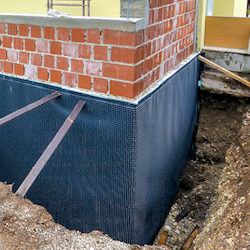Residential Construction
OSHA recognizes that residential construction sites can be very different from commercial sites as they relate to excavations. In 1995, OSHA suspended the requirements of 1926.652 to house foundation/basement excavations. (OSHA Letter of Interpretation 1995-06-30).
The exemption applies only if ALL six of the following conditions are present:
- the house foundation/basement excavation is less than 7½ feet in depth or is benched for at least 2 feet horizontally for every 5 feet or less of vertical height;
- the minimum horizontal width at the bottom of the excavation is as wide as needed, but not less than 2 feet;
- there is no water, surface tension cracks or other environmental conditions present that reduce the excavation stability;
- there is no heavy equipment operating in the vicinity that causes vibration to the excavation while employees are in the excavation;
- work crews in the excavation are the minimum number needed to perform the work; and
- the work has been planned and is carried out in a manner to minimize the time employees are in the excavation.
However, it's important to note that OSHA 1910.652 does still apply if any of the above conditions are not met.
This policy applies to all house foundation/basement excavations including those which become trenches by definition when formwork, foundations, or walls are constructed. This policy does not apply to utility excavations (trenches) where 29 CFR 1926.652 remains applicable.
Knowledge Check Choose the best answer for the question.
5-8. What is the basic requirement regarding the residential basement/foundation exemption for excavations?
You forgot to answer the question!

